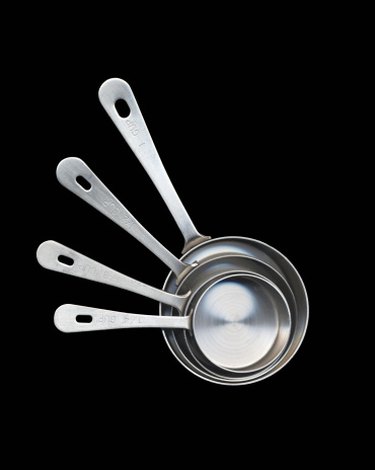
Successful baking and cooking requires accurate measurement of ingredients. Depending on the sources of recipes, the larger amounts are stated in cups, ounces, liters or spoons. Measuring cups and spoons are necessary for culinary tasks, as they provide much more accurate quantities than using teacups, drinking glasses or spoons from flatware or silverware sets.
Cups to Ounces
Video of the Day
A 1-cup measuring cup holds 8 ounces; a 3/4-cup measuring cup holds 6 ounces; 2/3 cup is 5 1/3 ounces; a 1/2 cup equals 4 ounces; a 1/3 cup is 2 2/3 ounces; 1/4 cup holds 2 ounces and 1/8 cup is 1 ounce.
Video of the Day
Cups to Liters
Many recipes with European origins list ingredients in liters and milliliters rather than ounces. One cup equals 237 milliliters; 3/4 cup is 177 milliliters; 2/3 cup equals 158 milliliters; 1/2 cup holds 118 milliliters; 1/3 cup equals 79 milliliters; 1/4 cup holds 59 milliliters and 1/8 cup is 30 milliliters.
Cups to Spoons
Converting cups to spoons is necessary when recipes are being cut in halves or quarters to produce smaller quantities. A cup is equal to 16 tablespoons or 48 teaspoons; 3/4 cup equals 12 tablespoons or 36 teaspoons; a 2/3 cup holds 10 2/3 tablespoons or 32 teaspoons; 1/2 cup is 8 tablespoons or 24 teaspoons; 1/3 cup equals 5 1/3 tablespoons or 16 teaspoons; a 1/4 cup measure holds 4 tablespoons or 12 teaspoons and 1/8 cup equals 2 tablespoons or 6 teaspoons. If a recipe calls for a scant cup of an ingredient, measure out a cup and then remove 2 tablespoons or 6 teaspoons.
Measuring Dry Ingredients
Sift dry ingredients such as flour, corn meal, cornstarch and powdered sugar before measuring to remove lumps. Use a flatware spoon to scoop the ingredients into a measuring cup and level off the top with the backside of a table knife blade. Do not pack the ingredients into the cup, shake the cup during filling or dip the cup into the material being measured, as these actions will produce an inaccurate measurement. The only dry ingredient that should be packed into a measuring cup is brown sugar, which requires packing due to its high moisture content.
Measuring Other Elements
Semi-soft components such as butter or shortening need packing into the cup with a table knife to remove air pockets. Lightly pack chopped or minced fruits, vegetables and meats into measuring cups. The most accurate way to measure liquids is in a transparent cup with clearly visible measurement lines on the side that has excess space at the top to prevent spills.